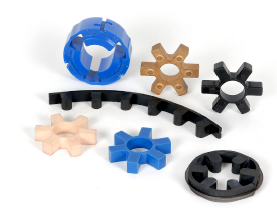Elastomers In Compression
We provides four forms of elastomer models to permit for extra flexibility in addressing particular application requirements. One piece models are utilized in the “L” and “AL” versions (known as spiders) and multiple portion “load cushions” are used in the “C” and “H” model couplings. The load cushions are in sets of 6 to 14 pieces based on coupling size.
Sound Center Spider
The solid center layout is typically utilized design when shafts in the driver and driven gear can be kept separate by a common gap
Open Center Spider
The open center style enables for that shafts with the driver and driven to be positioned inside of a quick distance
Open  center spiders provide shaft positioning versatility but have a decrease RPM capability
center spiders provide shaft positioning versatility but have a decrease RPM capability
Cushions
Employed exclusively for the C and H Type couplings
Load cushions are held in location radially by a steel collar that is connected to among the hubs
Snap Wrap Versatile Spider
Style and design lets for quick removal from the spider devoid of moving the hubs
Lets for shut shaft separation all the way up to the hubs highest bore
Greatest RPM is 1,750 RPM with all the retaining ring, but if made use of with all the LC Kind (with collar) the typical RPM rating in the coupling applies
Fashion is accessible in NBR and Urethane only, and in limited sizes
Spider Materials
SOX (NBR) Rubber
The regular materials that is highly flexible material that is certainly oil resistant
Resembles organic rubber in resilience and elasticity, and operates correctly in temperature ranges of -40° to 212° F (-40° to 100° C)
Urethane
Has 1.five instances higher torque capacity than NBR
Fantastic resistance to oil and chemicals
Material delivers significantly less dampening effect and operates at a temperature array of -30° to 160° F
Hytrel
Flexible elastomer designed for large torque and substantial temperature operations
Operates in temperatures of -60° to 250° F (-51° to 121° C)
Bronze
Rigid, porous, oil-impregnated metal insert solely for minimal speed (max 250 RPM) applications requiring higher torque capabilities
Not affected by water, oil, filth, or intense temperatures – operates in temperatures of -40° to 450° F (-40° to 232° C)